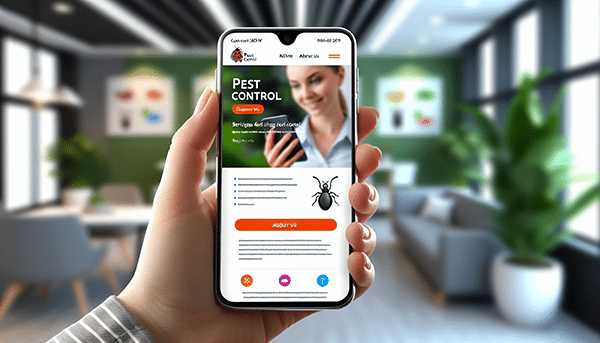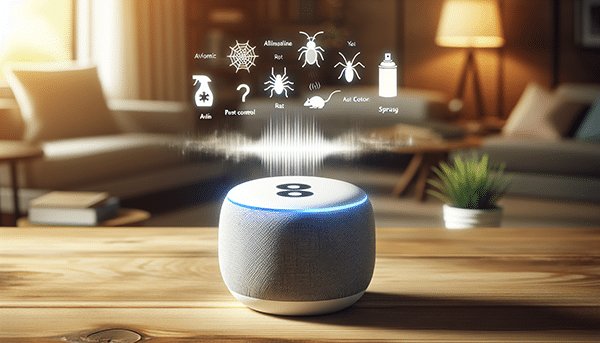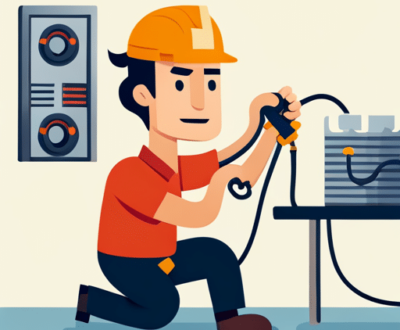Top Strategies for Effective SEO for Pest Control Companies
- April 18, 2024
- Content Marketing, Search Engine Optimization, WordPress SEO
Discovering how to stand out online can be a battleground for pest control companies. Simplify your journey with strategic SEO. Our concise guide unfurls proven SEO for pest control companies techniques, positions you in front of customers who need you, and avoids common pitfalls that could cost you visibility and sales.
Key Takeaways
- Effective local SEO strategies are vital for pest control companies looking to enhance online visibility, attract qualified leads, and improve search rankings by targeting localized keywords and optimizing their Google My Business profiles.
- Content marketing that includes comprehensive guides, FAQs, and engaging articles can establish pest control companies as industry authorities, driving user engagement and earning valuable backlinks for improved SEO.
- Technical SEO aspects such as site speed, mobile responsiveness, and the use of rich snippets are crucial in improving user experience and search engine rankings, and should be a focus for pest control websites to retain competitive advantage.
Unlocking the Potential of SEO for Pest Control Companies

Pest control companies can greatly benefit from local pest control SEO, or search engine optimization, as it amplifies their online visibility and accessibility to customers in need of pest control services. By appealing to people actively searching for extermination solutions, a pest control SEO agency brings qualified leads directly to pest control businesses, leading to higher search rankings and an increase in phone calls and bookings. Pest control SEO services play a crucial role in this process.
Understanding your target audience is key as it allows for optimization of SEO efforts towards traffic that is more likely to establish strong customer relationships. SEO for pest control is a more effective approach than traditional marketing techniques as it pulls in potential customers at the moment they are actively looking for services, thus being timely and relevant. Wondering how to harness this potential? Here are the details.
Mastering Keyword Research for Pest Control Visibility
To comprehend and attract a suitable client base for pest control businesses, keyword research plays a pivotal role, offering insights into local search behavior and preferences. Pest control companies can utilize keyword research tools like Google Keyword Planner, Moz, or SEMrush to generate keyword ideas, understand search volumes, competition, and local popularity to guide content creation.
Given the industry’s focus on serving particular geographic areas, localized keywords significantly contribute to pest control SEO by driving targeted leads and revenue. In SEO, keywords are the terms and phrases that people use to search online, which align with the content’s intent and can influence the ranking in search engine results.
Crafting a Local SEO Plan for Your Service Area
Optimizing Google My Business is fundamental for local SEO. It requires a complete and accurate profile, business hours, categories, and encouraging positive customer reviews. To manage a Google Business Profile, owners should search for their business and claim and verify the listing, or create a new one if it doesn’t exist.
Local SEO includes key practices like identifying local keywords that potential customers use, creating geographic landing pages, and using city or region information in meta tags. Local SEO success relies on having accurate and consistent business information (Name, Address, Phone number) across all online profiles.
The Essentials of On-Page SEO for Pest Control Websites
Title tags should be optimized by positioning the primary keyword towards the start and maintaining the length within 50 to 70 characters. Meta descriptions must be compelling, include relevant keywords, and adhere to a character limit of 140 to 160 for optimal display in search results.
Use headings and subheadings to create a clear narrative and guide readers through the content of the page. Incorporate internal links to help visitors navigate to related content and enhance the site’s structure for SEO.
Adding informative alt text for images can aid search engines and visually impaired users, thereby boosting the page’s SEO value.
Building an Authoritative Online Presence for Pest Control

Building an authoritative online presence is a two-pronged approach. It involves not just optimizing your website, but also actively creating and sharing helpful content. Some ways to do this include:
- Regularly publishing articles or blog posts that address specific pest problems
- Sharing seasonal pest control tips
- Providing preventative measures This can demonstrate your expertise and provide value to both existing and potential customers.
Engage in public relations efforts such as community service, hosting educational events, and participating in local business organizations to boost your company’s visibility and reputation. Actively participate on social media platforms to engage with the community, answer questions, and share useful content, further highlighting your company’s authority in pest control.
Content Marketing: Engaging and Educating Prospective Clients
Prospective clients can be effectively engaged and educated through content marketing. Developing long-form content that addresses common pests, treatments, and prevention methods positions your pest control company as a knowledgeable authority in the field.
Including the following on your website can significantly enhance the visitor experience and provide valuable education:
- FAQs
- Checklists
- A comprehensive pest control library
- Engaging case studies
High-quality, helpful content is key to earning backlinks, as it encourages sharing and recognition from both users and other reputable sites.
Strengthening Your Website’s Technical Backbone
Improving the functionality and ease of use of your website is fundamental to strengthening its technical backbone. Site speed optimization is critical for pest control websites as faster page loads improve the search experience and contribute to higher search rankings.
A website must be mobile-friendly since its absence can result in exclusion from search results, thereby adversely influencing ranking and organic traffic. Security must be a priority in technical SEO to facilitate search engine access and indexation, which is essential for maintaining search ranks and protecting user information.
Link Building: Earning Trust Through Quality Backlinks
Backlinks are considered one of the strongest ranking signals in SEO because search engines view them as votes of confidence in a website’s content. Quality backlinks from reliable publications and websites contribute positively to a site’s expertise, authoritativeness, and trustworthiness (EAT) value.
Effective tactics for earning quality backlinks include:
- Guest blogging on related industry or niche sites
- Partnering with complementary local businesses
- Utilizing social media to share content and tagging third-party resources
- Reaching out to industry publications
These strategies can help amplify the chances of earning backlinks.
Enhancing User Experience for Better SEO Outcomes

In SEO, user experience (UX) plays a critical role. Search engines prioritize sites that effectively satisfy user queries, and a positive UX on a pest control website is essential for engaging visitors and encouraging them to make contact.
Analyzing metrics like click-through rate (CTR) and bounce rates provides insights into the user’s engagement with search results and the website’s content, guiding improvements in meta titles, descriptions, and page content for enhanced UX and SEO.
Optimizing Site Navigation for Seamless User Journeys
Clear and logical site navigation aids both users and search engines in finding and indexing pest control website content efficiently. A well-structured site architecture with logical navigation can reduce bounce rates on pest control websites by making it easier for visitors to find the information they need.
Pest control websites should organize services into logical categories and subcategories, such as separating residential from commercial services. Implementing breadcrumb navigation under menus can help users understand their location within a pest control website and navigate with ease.
Mobile Optimization: Catering to the On-the-Go Customer
With many consumers using smartphones to search for local businesses, mobile optimization becomes critical for pest control websites. A mobile-friendly website significantly increases the likelihood that consumers will contact a local pest control business.
Ensuring a pest control website’s responsiveness and adaptability to different devices is crucial for capturing mobile traffic. Over half of all website traffic comes from mobile devices, highlighting the need for responsive design in pest control websites.
Speed Optimization: Keeping Your Site Fast and Efficient
As a technical ranking factor, site speed influences user experience and search rankings, with faster page loads resulting in a superior search experience.
Optimizing website speed involves:
- Compressing images
- Minimizing server response time
- Leveraging caching techniques
- Upgrading to faster web hosting
These steps are vital for keeping potential pest control customers engaged.
Regularly analyzing page load times using tools like Google PageSpeed Insights and implementing recommendations can continually improve a site’s speed and SEO performance. Page speed is critical, particularly on mobile, as a significant percentage of mobile site visitors will leave a page that takes longer than three seconds to load, emphasizing the need for speed optimization.
Advanced SEO Techniques for Competitive Edge

Advanced SEO techniques are required to maintain a competitive edge. Backlinks are a crucial ranking factor in SEO, serving as indicators of a website’s authority and reliability, which can contribute to a competitive edge in Search Engine Results Pages (SERPs).
SEO split-testing allows pest control companies to fine-tune their web presence by evaluating different variables, which can lead to increased organic traffic and a stronger position against competitors.
Voice Search Optimization for Pest Control Queries
Voice search queries for pest control are typically longer and more conversational, making long-tail keywords crucial for optimization. An FAQ page with concise answers to common pest control questions is effective for appearing in voice search featured snippets.
High-quality, informative content on pest control topics increases the likelihood of being selected for voice search results. Given the increasing popularity of voice search, it becomes imperative to optimize your site for this trend.
Utilizing Rich Snippets for Enhanced Search Display
Rich snippets provide a concise summary of a pest control company’s web page in search results with enhanced features like star ratings, author photos, and images that make the listing more interactive and visually appealing.
Utilizing schema markup helps search engines understand and display important information in search result snippets, which can improve the chances of a pest control company ranking higher in the SERPs. Implementing structured data through schema markup is encouraged by search engines, as evidenced by Google’s creation of a rich snippet testing tool.
Measuring and Adjusting Your SEO Strategy

A key step towards SEO success is to measure and adjust your SEO strategy. Gain comprehensive data on web traffic sources, visitor behavior, and keyword performance using tools such as Google Analytics for your pest control SEO.
Regularly monitor search engine results page (SERP) rankings to assess the visibility of your pest control company’s website to potential customers. Examine conversion rates to understand how effectively your pest control website converts visitors into customers, which can guide optimizations for better performance.
Analytics and Reporting: Understanding Your SEO Data
Setting clear SEO goals using analytics platforms like Google Analytics and Google Search Console provides a roadmap for continual improvement and innovation in SEO strategies. Google Analytics is instrumental in understanding the source of a pest control company’s web traffic as well as the behavior of site visitors, which are key to assessing SEO effectiveness.
Pest control companies can leverage tools like Google Analytics to monitor SEO progress, gain valuable insights into website traffic, and pinpoint optimization opportunities, hence understanding their SEO return on investment.
A/B Testing for Optimized Pest Control SEO Tactics
SEO A/B split-testing is a technique to make changes to a set of pages to evaluate the impact on click-through rates, organic traffic, and search rankings, differentiating from conversion rate optimization which focuses on user behavior rather than page ranking.
SEO A/B testing is conducted by categorizing pages of similar intent into Control and Variant groups to evaluate the effect of changes by tracking key SEO metrics.
SEO A/B testing enables pest control companies to:
- Verify the efficacy of website changes in a controlled manner
- Ensure optimal decision-making for SEO strategies
- Minimize the risk of introducing adverse modifications.
Summary
In summary, SEO is an essential tool for pest control companies to enhance their online visibility, attract qualified leads, establish strong customer relationships, and gain a competitive edge in the industry. By understanding your audience, mastering keyword research, crafting a local SEO plan, building an authoritative online presence, enhancing user experience, and utilizing advanced SEO techniques, pest control companies can effectively leverage SEO to boost their business performance. Remember, SEO is not a one-time task but an ongoing process that requires measurement and adjustment for continuous improvement and innovation. Now, it’s your turn to implement these strategies and see your pest control business soar.
Frequently Asked Questions
How companies are using SEO?
Companies are using SEO to guide customers through the buying process and establish authority in their industry, leading to increased visibility and website traffic. This is essential for reaching and engaging potential customers.
Is SEO right for my business?
Yes, SEO is important for your business regardless of its size, success, or industry. It can drive organic traffic, generate leads, increase conversions, and grow brand awareness in the long run.
Why is SEO important for pest control companies?
SEO is important for pest control companies because it enhances their online visibility, attracts qualified leads, and strengthens customer relationships by making their services more accessible to potential clients.
How can I improve my local SEO?
To improve your local SEO, optimize your Google My Business profile, use local keywords, create geographic landing pages, and ensure consistent business information across all platforms. These steps can enhance your online visibility and attract more local customers.
How does content marketing help in building an authoritative online presence?
Content marketing helps build an authoritative online presence by regularly publishing valuable content that showcases expertise and provides value to the audience. This builds trust and credibility, establishing authority in the industry.
About us and this blog
We are a digital marketing company with a focus on helping our customers achieve great results across several key areas.
Request a free quote
We offer professional SEO services that help websites increase their organic search score drastically in order to compete for the highest rankings even when it comes to highly competitive keywords.








